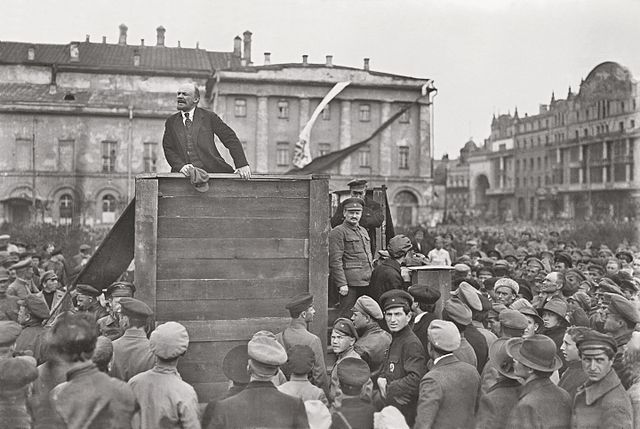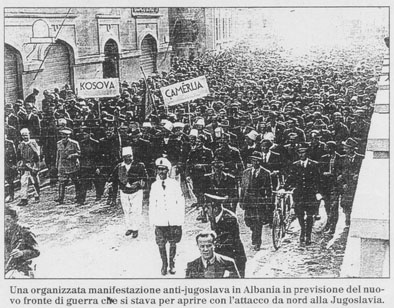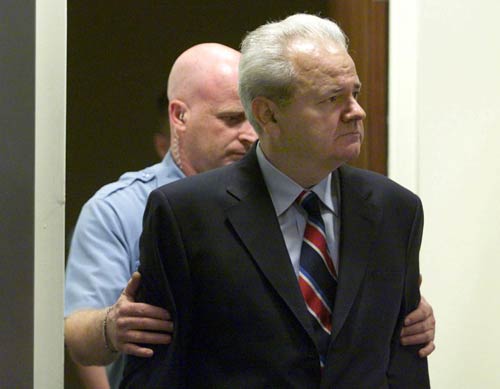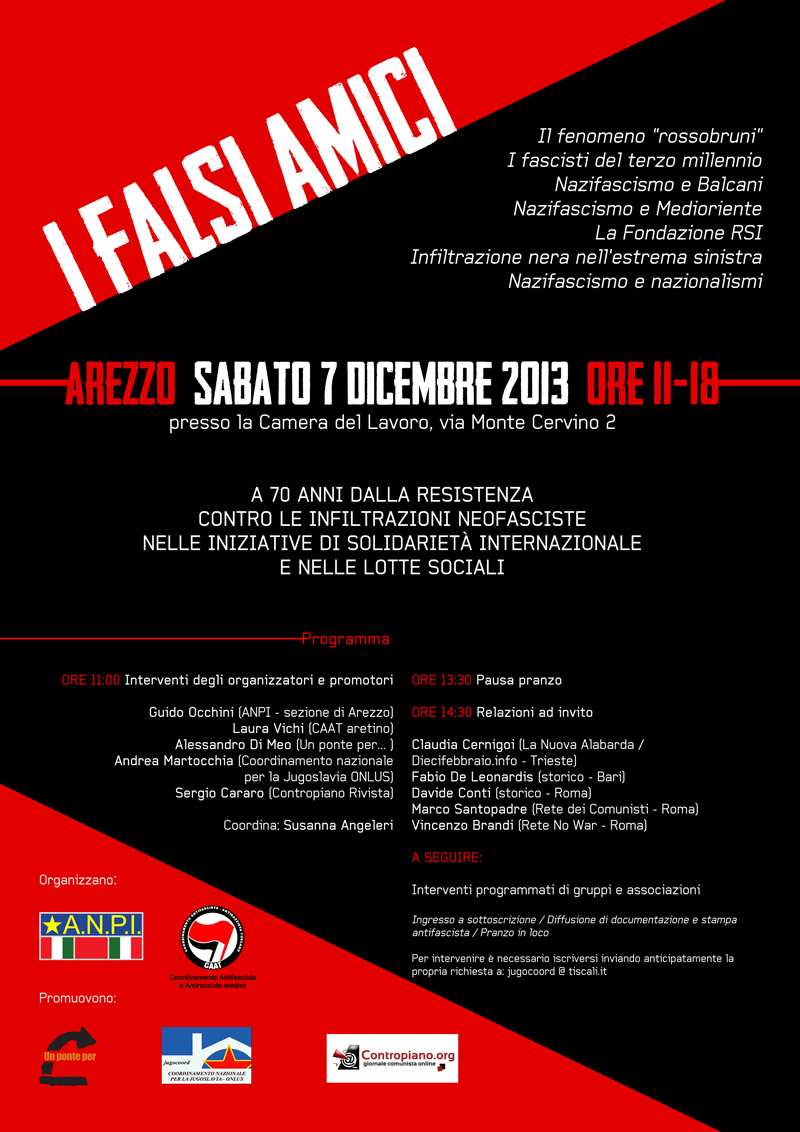Comrades and companions, esteemed guests, it is my great honour and privilege to greet you and to congratulate this great anniversary in this historic place which means so much to us. I do so in the name of the former numerous members of the KP and SK BiH, that counted more than 425,450 members. I do so in the name of the surviving and the existing League of Communists of Bosnia and Herzegovina.
My intention is to try to remind you, as much as possible, even in one part, of the most significant historic values and results our party had in countering fascism and managing the National Liberation War during the World War II.
On 10 April, Germany and Italy proclaimed a new fascist country – NDH (Independent State of Croatia).
On that same date, a session of the Political Bureau of the KPJ Central Committee was held in Zagreb when they carried out the latest analysis of the catastrophic consequences, determining that the conflict between fascism and USSR together with the rest of the world was inevitable. For that reason, it was agreed to establish the conditions for our national liberation war as soon as possible. New Army Committee within the CK KPJ was founded and they brought the decision to transfer the management of the Party to Belgrade.
After dividing Yugoslavia and establishing command over the country, on April 29 Hitler designated Serbia as his particular zone of interest and occupation and appointed his commissioner Quisling government, led by Milan Nedic, former Minister of the Interior, and a well-known "expert" for killing communists. They announced strict repressive measures of the occupant, where each breach of loyalty or killing a German soldier would be drastically punished by killing 100 Serbian citizens, which they did.
In May 1941 was held a very successful May counselling of the CK KPJ Political Bureau with all the representatives and officials of the Party from Slovenia, Croatia, Bosnia and Herzegovina, Montenegro, Serbia and Vojvodina, with the aim of adjusting the Party to the newly established conditions and the new programme of communist work in Yugoslavia. They agreed that the divided Yugoslavia cannot represent an obstacle to continue with further decisive, single actions in the joint fight for its liberation and the new democratic transformation. It was also agreed to obtain the approval of former parliamentary parties of the Kingdom of Yugoslavia for their participation in the war.
Additionally, it was agreed to establish a more organized reception of the new members to the Party, including those who already proved themselves as revolutionaries, as well as the young and the village population. They also discussed the specific issues regarding the method, content and the manner of preparing and training the fighters and the logistics to organize the rebellion.
On the day Germany attacked USSR, June 22, the Political Bureau of the CK KPJ held a session and brought the decision to immediately initiate armed struggle against the occupant. This fight should strategically grow into the overall national Partisan rebellion for liberation and social transformation of Yugoslavia.
In the announcement issued to the people of Yugoslavia on that occasion, it is stated: ”Those of you who are gasping for air under the boot of the occupant, those of you who truly love freedom and independence, those of you who want to break free from the fascist slavery – you should know that the time has come to fight for liberation from the fascist occupants...Proletarians from all around Yugoslavia, take your positions – to the front rows of your avant-garde, Communist Party of Yugoslavia!...Prepare yourselves immediately for the last and final battle! Destroy the fascists!”
On June 27, the Central Committee of the Communist Party of Yugoslavia established the General Headquarters of the National Liberation Army and Partisan Detachments of Yugoslavia (NOV and POJ) instead of its former Army Committee, and appointed Josip Broz Tito as the Commander. In the days of decision, Tito and his associates work on the concept of developing the armed rebellion in the form of a Partisan war and issue instructions for the formation and manner of action of the Partisan units, that are supposed to be created from the experienced diversionist groups and squads. On July 4, 1941 on the session of the Political Bureau of the CK KPJ in Belgrade was brought the decision on rising rebellion in Yugoslavia and initiating the armed fight. All national and province authorities of KPJ were informed about the decision and some members of the Partisan Supreme Headquarters and selected Party activists were sent on the field to provide assistance as instructors and establish relations with the aim of better implementation of all the decisions.
Tito, Ivan Milutinovic, Aleksandar Rankovic and Ivo Lola Ribar remained in the Supreme Headquarters in Belgrade. Parallel with the Party activities, League of Communist Youth of Yugoslavia (SKOJ) also acted actively and it had already grown into a revolutionary and modern anti-fascist youth organization, and its Secretary General Ivo Lola Ribar was also a member of the Supreme Headquarters.
Following the invitation of the KPJ, the members of the Party and SKOJ were the first ones to join the Partisans and they made 70 to 80% of the total number of Partisans, and many of them became important military and Party directors. It is believed that 100,000 members lost their lives during the National Liberation War and the revolution.
Only a few details from the period from the entrance of the occupants in Yugoslavia to the final decision on raising the general national rebellion on July 4, 1941 (3 months) the following happened:
- On April 17, the surrender of the Yugoslavian army was signed in Belgrade.
- On April 17, the President of NDH, Ante Pavelic, issued the order on introducing extraordinary courts with short-trial verdicts and invited Ustashe to abolish Serbs, Jews and Roma.
- On April 27, Hitler visited Maribor and issued the order to expel all the Slovenians from Styria and Carinthia, and in May was brought the decision to expel 200,000 Slovenians from Slovenia.
- On May 4, Hitler stated that the German forces in Yugoslavia captured 6,298 officers and 337,864 NCOs and soldiers of Serbian and Slovenian nationality who were transferred to concentration camps.
- On June 22, the German military commander for Serbia ordered Milan Acimovic, the Minister of the Interior of Serbia, to arrest in the night between June 22 and 23 all the communists from Belgrade and the participants of the Civil War in Spain. The same was done in the cities of Nis, Kragujevac, Uzice, Cacak and mines Rtanj, Trepca and Bor.
- They continued organizational and personnel strengthening of basic, municipal, city, county, district and province organizations and bodies of KPJ in establishing fast and secure coordination mechanisms within the Party and conspirator relations. It referred representatives of the Party bodies and the military committees to certain places where they would provide advice in preparing the uprising.
- It dedicated more attention to selection and establishment of provincial commissioners, cells and KPJ organizations. There were significant activities in the area of collecting weapons, equipment, training in handling weapons and medical courses.
- They established army committees and authorities at all levels of organizational structures, along with diversion and task forces for performing specific assignments.
- They also gathered significant intelligence and information estimates regarding the size, structure and the importance of enemy forces.
- They monitored the activity and the role of domestic servants of the occupants and their role in massive crimes and killings of innocent people and provided all possible protection and assistance in escapes.
There are numerous examples of preparations that were carried out in time and the readiness to raise a rebellion.
We are all familiar with the circumstances and official dates of uprisings in the republics: July 7 in Serbia, July 13 in Montenegro, July 22 in Slovenia, July 27 in Bosnia and Herzegovina and Croatia, and October 11 in Macedonia, even though some armed conflicts occurred before as well, especially in the so-called NDH.
The results of all the preparations of the Party were obvious in the first days of the National Liberation War (NOB). Major parts of our territories, including the whole Western Serbia, Montenegro, Bosnian Krajina, Kordun and Lika up to Knin have been liberated in a relatively short time and placed under our full control. That was the only and major liberated territory in the enslaved Europe.
The Fourth Enemy Offensive was planned in Rome and in Zagreb, and it started on January 20 in Karlovac and ended on the river Neretva in March 1943. The assignment of numerous and well-armed Italian, German, domestic, Ustashe and Chetnik military formations was to close the area around Knin, around Bosnian Krajina, and Bihac Republic where the Supreme HQ, CK KPJ and all the structures of the First AVNOJ session were located, as well as the central hospital of NOV and PO on Petrova Gora, Grmec, Cemernica etc, and to destroy NOV and PO. At that moment, the Supreme Headquarters ordered a part of the proletarian and task brigades to clear the field towards the South and enable retreat of 4,000 wounded and 80,000 refugees across Donji and Gornji Vakuf, all the way towards Prozor and Jablanica, Herzegovina and Montenegro. The remaining forces had to keep the enemy behind day and night and defend the free territories. Due to difficult and heroic battles and successful manoeuvres of our units on Neretva, this offensive was righteously called the most human battle of the World War II – the Battle for the Wounded.
It definitely disclosed the strategy of the Chetniks, the occupant’s servants, in the fight against the communists.
The Fifth Enemy Offensive, also called the Battle of the Sutjeska, was one more attack that was planned in detail to finally destroy the Supreme Headquarters and authorities of NOB. The ration of fighters was 6 to 1, i.e. 120,000 soldiers on the side of the occupant and the local traitors, against our 16,000 fighters and 4,000 wounded, which says enough of the intention of the enemy. Of course, the occupants had the latest firearms and equipment and enormous logistics behind them.
This was our most uncertain and the hardest battle, but we won it, after enormous efforts and sacrificing human lives and material destructions.
During these fights, Tito was wounded on June 9, 1943 as the only supreme commander in the World War II, who was also side by side with his soldiers, wounded and refugees in the front rows.
After losing the battle, the German commander of the operation, wrote a statement to his command in Berlin:
"The course of the battle showed that the Communist forces, under Tito’s command, were well-organized, skilfully managed and have moral to fight that you have to admire. His command was supreme, flexible and active in defence…There is no doubt that the communists are a tough enemy, and the only units that can fight with them are the ones that are equipped and armed with everything that could be used to fight in the mountains and who are used to greatest physical efforts."
After all these offensives, the Second Session of the Anti-Fascist Council for the National Liberation of Yugoslavia (AVNOJ) and the Raid on Drvar (Operation Rösselsprung), the allies are sending the assistance they promised only in September 1944, when they also acknowledge our enormous casualties and the results of the fight.
In the end, comrades and companions, and esteemed guests, allow me to emphasise, as a local patriot, that our Bosnian Krajina makes ¼ of the total BiH territory, and that such tiny geographic space produced almost 20,000 proud and brave anti-fascist and partisan fighters, arranged in 20 heroic Krajina task brigades, and our city of Banja Luka gave 21 national heroes, as well as Bosanski Petrovac, Drvar, Prijedor etc.
Our territories suffered massive destructions and battles, but we also brought many faithful, national liberation and political decisions for the future of our common homeland.
I would also like to remind you that the Communists of our City, the county, district and province committees were the first ones who honorably prepared to raise the rebellion, This is confirmed by the fact that in the first three days of the uprising, they freed the territory from Banja Luka across Bosnian Krajina, Kordun and Lika, all the way to Knin, which represented the largest freed territory in the enslaved Europe in July 1941.
My humble presentation is only a small part of the historic truth and the famous contribution KPJ had in fight against fascism and creating the completely new, free and equal, modern and promising, our dear homeland in the community of all its nations, that we lived in happily and in harmony for 45 years.
Raca Mirko
Drugarice i drugovi uvaženi gosti , čini mi veliko zadovoljstvo i čast da vas danas ovdje na ovom našem najznačajnijem istorijskom mjestu mogu pozdravitii i čestitati vam ovaj naš veliki jubilej .
Činim to u ime nekada brojnog članstva KP i SK BiH koja je imala preko 425.450 članova,
Činim to i u ime preživjelog i sadašnjeg Saveza komunista BiH.
Namjera mi je da vas danas koliko je to uopšte moguće, makar djelimično, pokušam podsjetiti na najznaćajnije istoriske vrijednosti i rezultate naše partije u vremeno borbe protiv fašizma i istovremeno vođenja N O B u Drugom svjetskom ratu.
Konsolidacija i obnova naše Partije od 1937 do 5. zemaljske koferencije koja je održana u Zagrebu od 19. do 23. oktobra 1940god. i izborom novog rukovodstva na čelu sa drugom Titom su veoma kvalitatnim analizama unutrašnjih i međunarodnih prilika, jasno odredili svoje mjesto i ulogu u nastupajućoj kataklizmi Drugog svijetskog rata. Ta sposobnost i realnost u procjeni i donešeni program za pripremi odbrane Jugoslavije potvrđuje i odluka o osnivanju Vojne komisije pri CK KPJ. Drug Tito zaključije rad 5. koferencije rečenicom „ Drugovi, nalazimo se pred odlučujućim danima, sada naprijed u konačnu borbu. Slijedeću našu koferenciju moramo održati, u slobodnoj zemlji i od tuđina i od kapitalista“. Ta njigova izjava je data 5.5 mjeseci prije zvaničnog napada na Jugoslaviju). Kada su počeli pregovori između Kraljevine Jugoslavije i Njemačke o pristupanju Trojnom paktu, KPJ je pozvala narodne mase na otpor izdajničkoj vladii i izdala proglas sa slijedećim sadržajem: „Još je vrijeme da spase nezavisnost, još je vrijeme da se pomrse protivnarodni planovi izdajnika naroda... Organizujmo protestne skupštine i mitinge! Neka se slije narodna snaga u jedan narodni front, u borbu za ostvarivanje tih zahtjeva i naša će sloboda i nezavisnost biti osigurana“.
Ovaj poziv partije na demonstracije su organizovano počele 24. 25. 26. marta 1941 god. u Kragujevcu i Kraljevu i mnogim drugim mjestima Jugoslavije a najmasovnije u Beogradu 27. marta gdje je prisustvovalo oko 100.000 demostranata na kojima su govorili naši odabrani članovi i tako dobili potreban legimitet. Kao rezultat ovih demonstracija 27. marta je izbio vojni puč i promjena vlade. Na ovim skupovima je a posebno u Beogradu uz oko 100.000 su govorili inaši istaknuti revolucionari čime je partija dobijala svoj legimitet . Ovi događaji su podstakli vojni puč i imenovanje nova vlade. U nadi da će nova vlada organizovati odbranu zemlje a prema svojim opredjeljenjima rukovodstvo partije je sve svoje članove, vojne obvenike uputila da se odazovu odbrani zemlje i tako ostvaruju partijska opredjeljenja za odbranu Jugoslavije. Tada vodeće buržoaske snage su odbile uslugu komunista o čemu je Tito obavjestio Kominternu. Ovi događaji nisu iznenadili Hitlera iako su mu značajno odgodili planirani napad na SSSR.
Samo poslije 10 dana Hitler je prešao na ostvarivanje ranije donešenog plana o munjevitom i trajnom rušenju zajednice Balkanskih naroda pa je 6. aprila sa najsnažnijom eskadrilom bombardovao Beograd i sa 50 divizija rušilački primorao Jugoslaviju na kapitulaciju 17 aprila 1941 godine. Dva dana ranije t.j.15 aprila kralj i njegova vlada su preko Pala i Nikšića napustili zemlju.
Već 10. aprila Njemačka i Italija su proklamovale novu fašističku državu NDH. Istoga dana u Zagrebu je održana sjednica Političkog biroa CK KPJ na kome je izvršena najnovija analiza uzroka nastale katastrofe i potvrđena neizbježnost sukoba fašizma sa SSSR i ostatkom svijeta.za što treba što prije stvatati uslove za našu narodno oslobodilačku borbu. Pri CK KPJ je imenovan novi Vojni komitet i donešena odluka da se rukovidrtvo partije preseli u Beograd. Komadanjem i podjelom Jugoslavije 29.aprila, Hitler je Srbiju proglasio svojim posebnim interesnim i okupacionim zonom i imenovao svoju komesarsku kvislinšku vladu na čelu sa Milanom Nedićem nekadašnjim ministrom unutrašnjih poslova, poznatim stručnjakom za likvidaciju komunista. Najavljene su najstrožije represivne mjere gdje će za svaku nelojalnost ili za ubistvo svakog Njemačkog vojnika usljediti drastične odmezde i likvidacija 100 stanovnika Srbije.
U Prvomajskom proglasu, CK KPJ je uputio poruku radničkoj klasi i narodima Jugoslavije, da će KPJ još odlučnije organizovati i voditi borbu protiv okupatura i domaćih izdajnika i boriti se protiv raspirivanja nacionalne mržnje i za bratstvo svih naroda u Jugoslaviji i na Balkanu.
U maju 41. god. je održano veoma uspješno savjetovanje Politbiroa CK KPJ sa svim predstavnicima i rukovodiocima partija iz Slovenije , Hrvatske, Bosne i Hercegovine, Crne Gore i Vojvodine sa namjerom da se partija prilagodi novo nastalim uslovima i novom programu rada komunista u Jugoslaviji. Rasparčana Jugoslavija nemože biti razlog za nastavak daljeg i odlučnog i jedinstvenog djelovanja u zajedničkoj borbi za njeno oslobođenje i novi demokratski preobražaj. Dogovoreno je da se dobije saglasnost od bivših parlametarnih stranaka za njihovo učešće u oslobodilačkom ratu. Takođe je dogovoren organizovaniji prijem novih članova u partiju iz redova već dokazanih revolucionara, omladinaca i seoskog stanovništva. Razmatrana su i konkretna pitanja metoda, sadržaja i načina priprema i osposobljavanja boraca i logistike u organizovanju ustanka.
Na sam dan napada Njemačke na SSSR 22. juna Polit biro CK KPJ je održao sjednicu i donio odluku da se odmah pristupi pokretanju oružane borbe protiv okupatora. Ova borba treba da strategiski izreste u svenarodni partizanski ustanak za oslobođenje i društveni preobražaj Jugoslavije. U proglasu narodima Jugoslavije koji je tim povodm izdat se kaže: „V i koji stenjete pod okupatorskom čizmom, svi vi koji ljubite slobodu i nezavisnost, koji nećete fašističkog robstva—znajte da je kucnuo čas borbe za vaše oslobođenje od fašističkog osvajača... Proleteri sviju krajeva Jugoslavije, na svoja mjesta—u prve borbene redove oko vaše avangarde, KP Jugoslavije! ... Spremajte se hitno za posljednji i odlučni boj! Uništavajte fašiste!“.
27 juna CK KPJ je umjesto dotadašnjeg Vojnog komiteta formirao Glavni štab NO i POJ a za komadanta imenovao Josipa Broza Tita. U tim odlučujućim danima Tito sa saradnicima razrađuje koncepciju razvoja oružanog ustankau, po formi partizanskog rata i izdaje uputstva za formiranje i način djelovanja partizanskih odreda, koje treba stvarati, od već iskusnih diverzantskih grupa i odreda.
4. jula 1941 god. na sjednici Politbiroa CK KPJ je Beogradu donesena je odluka o dizanju ustanka u Jugoslaviji i otpočinjanju oružanih borbi. O tome su odmah obavještena sva nacionalna i pokrajinska rukovodstva KPJ i upućeni pojedini članovi Vrhovnog štaba i odabrani aktivisti da na terenu kao instruktori pomognu i uspostave veze kako bi se sve odluke i međusobne bolje sprovodile. U Beogradu pri Vrhovnom štabu su ostali Tito, Ivan Milutinović, Aleksandar Ranković i Ivo Lola Ribar.
Paralelno je sa aktivnostima partije, je veoma aktivno radio i SKOJ, koji je već prerastao u revolucionarnu i modernu antifašističku organizaciju mladih, čiji je Generalni sekretar Ivo Lola Ribar bio i član Vrhovnog štaba..
Na poziv KPJ članovi SKOJ-a su među prvima otišli u partizanske odrede i sačinjavali 70 do 80 % partizanskog sastava, a značajan broj njih su postali značajni vojni i partijski rukovodioci. Smatra se da je u toku NOR i revolucije preko 100.000 članova SKOJ-a poginulo .
Samo nekoliko detalja iz vremena od ulaska okupatorskih snaga u Jugoslaviju do konačne odluke o dizanju opštenarodnog ustanka 4. jula 1941 god. (3 mjeseca) :
---.15. aprila su Njemačke snage iz Zvornika stigle na Pale i zarobile Vrhaovnu komandu vojske Kraljevine Jugoslavije, zatim su sišle u Sarajevo i potpisale kapitulaciju Jugoslovenskih snaga u BiH.
---.17 aprila je u Beogradu potpisana kapitulacija jugoslavanske vojske.
--- 17 aprila je poglavnik NDH Ante Pavelić izdao naredbu o uvođenju vanrednih sudova o presudama po kratkom postupku i pozvao ustaše na uništenje srba, jevreja i cigana..
--- 27.aprila je Hitler boravio u Mariboru i izdao naredbu da se protjeraju svi slovenci iz Štajreske i Koruške a u maju ja donešena odluka da se iz Slovenije protjera 260.000 slovanaca. --- 4. maja Hitler je izjavio da su njemačke snage u Jugoslaviji zarobile 6.298 oficira i 337.864 podoficira i vojnika srpske i slovenačke narodnosti i da su sprovedeni u koncenrtacione logore.
--- 22 juna njemački vojni zapovjednik za Srbiju, je naredio Milanu Aćimoviću ministru unutrašnjih poslova Srbije da noću između 22 i 23 juna pohapsi sve komunoste Beograda i učesnike građanskog rata u Španiji. Isto važi i za gradove Niš, Kragujevac, Užice, Čačak i rudnike Rtanj, Trepča i Bor.
Od završetka 5. koferencije KPJ u Zagrebu pa do 4. jula Dana ustanka naroda Jugoslavije u trajanju od oko 8,5 mjeseci u veoma složenim , teškim i neizvjesnim okolnostima je naša partija veoma odgovorno ostvarivala svoje programske ciljeve i zadatke.
Nastavila je organizaciono o kadrovsko jačanje i osposobljavanje osnovnih, opštinskih, gradskih, srezskih , okružnih i pokrajinskih organizacija i organa KPJ i uspostavljanju što bržu i sigurniju unutar partijskihu koordinaciju i konspirativnih veza.
Upućivala je predstavnike organa partije i vojnih komiteta na određena mjesta da putem savjetovanja pomognu u pripremama za dizanje ustanka.
Posvetila je veću pažnja odabiru i osnivanju seoskih povjerenika , ćelija i organizacija KPJ.
Značajne aktivnosti su vođene oko prikupljanja oružja, opreme, obuke u rukovanju i sanitetski kursevi.
Osnivane su Vojne komisuje i rukovodstva na svim nivoima organizacionih struktura, ali i diverzanske i udarne grupe za obavljnje specificnih zadataka.
Prikupljane su značajne obavještaje i informativne procjene oko veličine, strukture i važnosti neprijateljskih snaga.
Praćena je aktivnost i uloga domaćih sluga okupatorai hjihove uloge u masovnim pokoljima i ubistvima nedužnog stanovništva i obezbjeđivana moguća zaštita i pomoć u zbjegovima.
Brojni su primjeri blagovremeno izvršenih priprema i iskazane spremnosti za dizanja ustanka.
Poznate su nam okolnosti i zvanični datumi dizanja ustanaka po republikama : 7. juli u Srbiji, 13. juli u Crnoj Gori , 22 juli u Sloveniji, 27 juli u Bosni i Hercegovini i Hrvatckoj i 11. oktobar u Makedoniji mada je samoodbrandbenih oružanih sukoba bilo i ranije a posebno u NDH.
Rezultati svih pripremnih radnji naše partije su bili očigledni u prvim danima NOB-a. Veliki dijelovi naših teritorija u kojima gotovo čitava zapadna Srbija , Crna Gora , Bosanska Krajina, Kordun, Lika do Knina su u velikom i tradicijonalnom borbenom zanosu za kratko vrijeme bili oslobođeni i stavljeni pod našu potpunu kontrulu. To je bila jedina i velika oslobođena teritorija u porobljenoj Evropi.
Taj furiozni početak, dobro organizovano i primjereno vođenje oružane borbe, stečena iskustva i samopouzdanje, su bili motiv u svim budućim i nadčovječanskim borbama. Drugi jednako važan motiv je bio, jasni ciljevi borbe u stvaranju nove i pravednije zajednice Jugoslavenskih naroda koje je partija godinama nosila u svom programu, a Tito konstantno ponavljao:
„Naša narodnooslobodilačka borba nebi bila istovremeno i tako uporna i uspješna kada u njoj narodi nebi vidjelii konačnu pobjedu nad onima koji su ih do sada ugnjetavali, i ponižavali. Narodnooslobodilačka borba bi bila samo fraza i prevara da u sebi nenosi borbu za slobodu, jednakost, ravnorpavnost i bratstvo svih njenih bratskih naroda“.
Bili smo sami , bez razumjevanja užeg i šireg okruženja, gladni , goli i bosi, sa i desotruko brojnijim i naoružanijm neprijateljima i domaćim izdajnicima koji su nametali, umjesto antifašističkog, građanski rat. Ogromna materijalna razaranja i ljudske žrtve kroz neprijateljske ofanzive koje svaka za sebe može poslužiti za izučavanje dokle sve mogu okupatori i bolesni umovi ići dabi ostvarili svije sulude namjere. Isto tako se mogu izučavati karekteristike i nadčovječanske napore žrtava fašizma, spremnih da brane svoj biološki opstanak i slobodu. Naša i svijetska istorijografija je odredilia naše mijesto, žrtve i zasluge u četvorogodišnjoj borbi protiv fašizma u Drugom svijetskom ratu.
Poznate su činjenice da su se najsudbonosnije i naj krvavije bitke i fašističke ofanzive vodile u centralnim dijelovima Jugoslavije t.j. u B i H gdje su najduže boravila rukovodstva NOB-a.
U Trećoj neprijateljskoj ofanzivi na Kozari koja je trajala oko 40 dana u julu 1942god. nijemci i utaše su natjerali u svoj obruč 3.000 boraca , 500 ranjenika i oko 60.000 izbjeglog stanovništa potkozarja pred ustaškim zločinima. Partizani su uspjeli probiti obruč i izvući oko 20.000 izbjeglica a neprojatelji su oko 60.000 zarobili odveli u Jasenovački logor. Ostali su poginulu u borbama ili pobijeni u zbjegovima.
Četvrta neprijateljska ofanziva je planirana u Rimu i Zagrebu, počela od Karlovca 20. januara a završila na Neretvi u martu 1943 god.. Zadatak veoma brojnih i dobro naoružanih Talijanskih, Njemačkih, domobranskih i ustaškuh i četničkih vojnih formacija je bio, zatvoriti obruč od Knina, oko Bosanske krajine i u toj velikoj slobodnoj treitoriji i Bihaćkoj republici u kojoj se nalazio Vrhovni štab, CK KPJ i sve strukture Prvog zasjedanja AVNOJ-a, ali i centralne bolnice NOV I PO, na Petrovoj gori, Grmeču, Čemernici i.t.d. Vrhovni štab je naredio da dio proletarskih i udarnin brigada čiste terene prema jugu i omoguće povlačenje oko 4.000 ranjenika i 80.000 izbjeglica preko Gornjeg i Donjeg Vakufa prema Prozoru i Jablanici, Hercegovini i Crnoj Gori. Naše ostale vojne formacije su morale danonoćno po vilikoj zimi zadržavati neprijetelja i braniti slobodne teritorije, Zbog teških i herojskih borbi i uspješnih manevara naših jedinica, ova ofanziva je sa pravom nazvana najhumanijom bitkom u drugom svjetskom ratu, bitkom za ranjenike.
Ona ja definitivno razotkrila strategiju četnika sluga okupatora, protiv komunista.
Peta neprijateljska ofanziva nazvana „Bitka na Sutjesci“, koja je opet studiozno pripremana da konačno uništi Vrhovni štab i rukovodstva antifašističke i NOB u kojoj je odnos broja boraca bio 120.000 okupatoskih vojnika i domaćih izdajnika, naprema 19.000 naših boraca i 4.000 ranjenika ili 6 na jednoga, dovoljno govori o namjerama neprijatelja, neračunajući tu na najsavremenije naoružanje i opremu i na odličnu borbenu logistiku koju su okupatori imali.
Bila je to naša najneizvjesnija i najteža bitka iz koje smo izašli kao pobjednici uz ogromne ljudske žrtve. Tito je bio jedini vrhovni komadant u drugom svjetskom ratu, koji je bio prisutan na prvim borbenim linijama uz svoju vojsku, ranjenike i izbjeglice na kojima je i sam bio ranjen 9. juna 1943 god.
Njemački komadant ove vojne operacije je poslije neuspjeha svojoj komandi dao pisminu izjavu:
„Tok borbe je pokazao da su komunističke snage, pod Titovom komandom, odlično organizovane,vješto vođene i da raspolažu borbenim moralom koji izaziva čuđenje. Njegovo komandovanje je bilo izvanredno gipko i u odbrani aktivno...Nesumljivo je da su komunisti veoma žilav protivnik, kome je dorasla samo jedinica opremljena i naoružana svim potrebama za vođenje borbe u planinama i naviknuta na najveće fizičke napore“.
I na kraju drugarice i drugovi i uvaženi gosti dozvolite mi da po našem običaju budem skromno i lokal patriota i naglasim da naša Bosanska krajina čini ¼ ukupne teritorije BiH a da je sa tako malog prostora iznjedrila preko 20.000 ponosnih i hrabrih partizanskih i antifašističkih boraca svrstanih u 20 krajiških herojkskih i udarnih brigada a naš grad Banja Luka je dao 21 Narodnog heroja kao i Bos. Petrovac, Drvar. Prijedor itd.
Na našim prostorima su se vodila velika borbena dejstva i ofanzive i donosile sudbonosne, narodn oslobodilačke i političke odluke za budućnost naše zajedničke otadžbine.
Isto tako želim podsjetiti da su komunisti našeg grada, sreskog, okružnog i pokrainskog komiteta časno i među prvima, najdosljednije izvršili pripreme za dizanje ustanka. To potvrđuje činjanica da je za tri dana bila oslobođena teritorija od Banja Luke preko Bos, Krajine, Korduna i Like do Knina što je predstavljalo najveću slobonu teritoriju u porobljenoj Evropi u julu 1941 god.
Banja Luka 05 .04. 2019 god.
Raca Mirko











